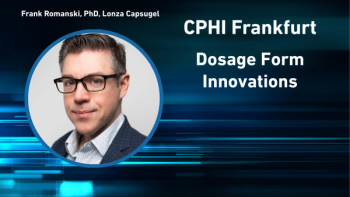
Equipment and Processing Report
- Equipment and Processing Report-08-21-2019
- Volume 12
- Issue 8
What Pharma Needs to Understand About Combination Product Development
Regulatory, cultural, and technical differences between drug and device development can pose challenges to pharmaceutical combination product development.
Developing a combination drug-device product brings together two distinct industries-pharmaceutical and medical device-to create an integrated product. “It’s not enough to merge specifications for the drug and the device that, on paper, are in sync; there are different sets of design criteria to factor in together,” notes Kerri-Anne Mallet, Clinical and Regulatory Affairs at Pharmatech Associates. “Beyond the technology aspects, there are cultural differences inherent in medical devices and drug development, akin to the differences between hardware and software development. There is a culture of ‘device people’ and ‘pharma people’.” A survey conducted by Pharmatech Associates and Merck aimed to identify cultural issues that may arise when people with specialized expertise from different industries come together to work on combination products (1). The survey identified “a perception that pharma regulations are more prescriptive, more step-based. In devices, there are other challenges. Test requirements are different and more varied; risk management and design controls play a huge part,” says Mallet. Cross-functional training for teams, understanding common goals, and mentoring are important for developing a collaborative working environment, she concludes.
Pharmaceutical Technology spoke with Mallet and with Bikash Chatterjee, Chief Science Officer and president; Lynn Hansen, RAC, director, Regulatory Affairs; and Caitlin Bancroft, Regulatory Affairs; all at Pharmatech Associates, about some of the differences in drug and device development, best practices for combination product development, and issues specific to Internet-connected combination products.
Development considerations
PharmTech: What are some of the key differences between drug development and device development?
Pharmatech Associates: Medical device development is generally more structured than drug development. Design history, inputs, outputs, and modifications are tracked and recorded in accordance with design controls. Devices also require human factors studies and usability engineering.
Medical device development, for devices regulated by FDA, requires that the development process follow a design control framework and, where applicable, testing and development that adheres to the corresponding consensus standards. The regulatory pathway also impacts the corresponding development characterization and evaluation and, if required, clinical strategy.
Drug development, by contrast, is driven to a great extent by the phases of the clinical program and the drug format (e.g., small molecule, large molecule, complex molecule). Consequently, there is much greater variability in terms of development activity. Drug development is typically a longer development process than the device’s shorter lifecycle. For instance, a main difference between the two would be the clinical trial phases of the development lifecycle. Drugs demand extensive clinical studies running concurrently with product and process development, whereas the product and process development of a medical device are usually complete prior to clinical studies.
PharmTech: What are some regulatory challenges for combination drug-device products?
Pharmatech Associates: There are three primary regulatory challenges that combination products companies face: conforming to the different product-specific regulations, the complex electronic Common Technical Document (eCTD) structure, and how to handle the final product.
For any company bringing a combination product to market, the challenge is adjusting to each set of regulations associated with the different constituent parts. Since July 2013, 21 CFR [Code of Federal Regulations] 4 has allowed companies to avoid duplicated efforts by clarifying regulatory elements that apply to combination products. Understanding whether your primary mode of action (PMA) is driven more by the device or drug is important to ascertain how best to integrate the core elements of 21 CFR 210, 211, and 820 together per the guidance provided by 21 CFR 4.
Drug and device manufacturers are always required to follow the quality management system and GMP requirements for the PMA constituent part, but these are supplemented by specific regulations governing other product components. Advanced planning and thorough investigation of the requirements are necessary. A common pitfall on the CMC [chemistry, manufacturing, and controls] side, for example, is not considering the device component as part of an extractables and leachables program.
The eCTD requirements for a drug product are daunting. Using eCTD for a combination product introduces a new level of complexity on an already burdensome process. It is difficult to determine where information about non-drug constitute parts should be included in eCTD, and familiar understanding and the use of the Regional Section of the eCTD format can be a challenge. Wise manufacturers address these obstacles by providing the most informative data on the device available in order to avoid observations during review.
When dealing with the final product, companies must remember to address basic logistical questions. With everyone pulling together the information on the individual constituents, it is easy to forget about the final product. Remember to consider the following: Who is responsible for the final product? Where is the final product being joined and packaged? Are the components and lifecycle being monitored and by whom? Missing these simple questions puts each individual product at risk.
Connected devices
PharmTech: Can you comment on some of the pros and cons for ‘connected’ devices, such as inhalers or wearable injectors?
Pharmatech Associates: There is no doubt that digital health is transforming the industry-from smart pills that transmit patient data to smart apps that can be used as part of a post-commercial pharmacovigilance and registry framework, the ability to gain insight via real time data is a boon to drug and clinical design optimization. HIPAA [Health Insurance Portability and Accountability Act] considerations, data integrity assurance, and cybersecurity are ‘must haves’ to ensure the ensuing analyses and conclusions are valid, safe, and sustainable.
PharmTech: What are some best practices for manufacturing connected devices?
Pharmatech Associates: Architecting the information management framework is essential before developing the technology. This order will ensure that the design control approach and, most importantly, the appropriate consensus standards, are applied to the connected device’s development. Manufacturing considerations at the design level, such as assembly, via DFM [design for manufacturability], and tolerance analyses to ensure specifications do not consume all of the allowable variation will greatly reduce the likelihood of issues at the commercial scale.
Reference
1. K. Mallet and D. Oppenheimer, “The Outsider’s Perception and Experience Within the Pharma and Device Industries,” Poster at the 2018 ISPE Annual Meeting and Expo (Philadelphia, PA, 2018).
Articles in this issue
over 6 years ago
New Machine Vision TechnologyNewsletter
Get the essential updates shaping the future of pharma manufacturing and compliance—subscribe today to Pharmaceutical Technology and never miss a breakthrough.




